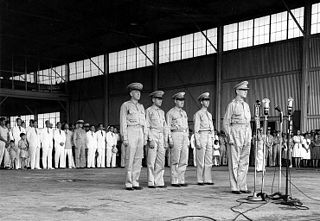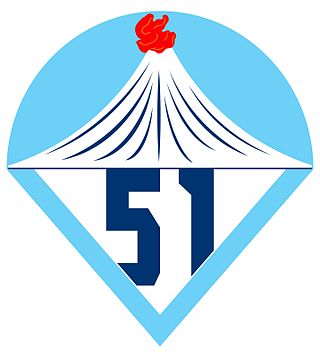
United States Army Forces in the Far East (USAFFE) was a military formation of the United States Army active from 1941 to 1946. The new command's headquarters was created on 26 July 1941, at No. 1, Calle Victoria, Manila, Luzon, the Philippines, with General Douglas MacArthur as commander. The Chief of Staff was Brigadier General Richard K. Sutherland and the Deputy Chief of Staff was Lieutenant Colonel Richard J. Marshall. The core of this command was drawn from the Office of the Military Advisor to the Commonwealth Government of the Philippines.

The Philippines campaign, also known as the Battle of the Philippines or the Fall of the Philippines, was the invasion of the American territory of the Philippines by the Empire of Japan and the defense of the islands by United States and the Philippine Armies during World War II.

The Battle of Bataan was fought by the United States and the Philippine Commonwealth against Imperial Japan during World War II. The battle represented the most intense phase of the Japanese invasion of the Philippines during World War II. In January 1942, forces of the Imperial Japanese Army and Navy invaded Luzon along with several islands in the Philippine Archipelago after the bombing of the American naval base at Pearl Harbor.

The 1st Infantry Division, Philippine Army, nicknamed Tabak Division, is the Philippine Army's primary infantry unit, and specializes in anti-guerrilla warfare. The division has been involved in combating terrorists in Southern Mindanao.

The 51st Infantry Division was a division of the Philippine Army under the United States Army Forces in the Far East (USAFFE).

The 21st Infantry Division was one of the 10 reserve division of the Philippine Army mobilized under the United States Army Forces in the Far East (USAFFE). The unit was involved in the delaying action against the Japanese invasion in the plains of Central Luzon, and the Battle of Bataan in 1942.

The 11th Infantry Division was one the reserve division of the Philippine Army that was mobilized in September 1941 under the United States Army Forces in the Far East (USAFFE).

The 71st Infantry Division was a reserve division of the Philippine Army that fought under the United States Army Forces in the Far East (USAFFE). It was known for its fight with Japanese invading forces in Layac Junction, that was ordered to hold until all retreating Fil-American forces of crossed into Bataan Peninsula.

The 81st Infantry Division was a reserve division of the Philippine Army under the United States Army Forces in the Far East (USAFFE). It was established in the prewar period and fought 1941–1942. Its troops are from Cebu, Bohol, and Leyte but most of its troops are Americans and junior officers are Filipinos coming mostly from Luzon. The division served in defense of Mindanao but it never commanded the 4 of its maneuver regiments but was supplemented with 61st Infantry from Panay and 73rd Infantry from Negros. Also, 2nd Regular Regiment was transferred to its command in the early part of Japanese invasion of Mindanao.
The North Luzon Force was a corps-sized grouping of the U.S.-sponsored Philippine Army, defeated in battle against the Japanese in 1941–42.

Luzon Force or Bataan Defense Force is a short-lived Field Army size unit created in the Philippines after the restructure of command organized by General Douglas MacArthur commander of US Army Forces in the Far East (USAFFE). He wished to control the 4 Commands from Australia with its representative in Corregidor Island. Major General Jonathan M. Wainwright IV was selected to command as the senior general officer in Bataan peninsula.
South Luzon Force was a corps-sized unit of the US Army Forces Far East (USAFFE) active in the Philippines between 1941 and 1942. Created along with other 3 commands under the USAFFE, it was officially announced on November 4, 1941, and BGen. George M. Parker was appointed to command, making him responsible for the defense of Southern Luzon of any invasion. General Parker established his headquarters in Fort William McKinley in Rizal province.
Negros Force was activated by USAFFE on September 1, 1941, to May 12, 1942. The force did not fought during the war but played in organizing units deployed to different sector. The force also continued to fight as a guerilla after the surrender. Although the two provinces was never united due to different affiliation of the commanders.
63rd Infantry Regiment is a reserve unit of Philippine Army activated and organized during World War II. I was organized from reservist and recruits high school and college students around the 6th Military District. It is part of the 61st Infantry Division activated to cover the island of Panay. The regiment fought entirely in Panay island until it was ordered to surrendered on May 12, 1942.
United States Forces in the Philippines (USFIP) is a unified command in the Philippines during World War II. It was the successor to the United States Army Forces in the Far East (USAFFE) which General Douglas MacArthur commanded. He moved to Australia as he evacuated as ordered by President Roosevelt in March 1942. The command only lasted two months as it surrendered by Lieutenant General Jonathan M. Wainwright to Lieutenant General Homma Masaharu commander of 14th Army of the Imperial Japanese Army.
91st Infantry Regiment is a reserve unit of the Philippine Commonwealth Army during World War II. It was a part of 91st Infantry Division, based in Leyte but was transferred to Luzon to augment the defense there. It was held as a reserve force of USAFFE but participated in the Battle of Bataan.
71st Field Artillery Regiment was a military unit of Philippine Army activated in 1941 as part of 71st Infantry Division. It fought in Luzon during Japanese landing and also in Bataan. All officers and men was captured during surrender of Fil-American forces in Bataan on April 9, 1942.
51st Field Artillery Regiment is a reserve unit of Philippine Commonwealth Army activated and organized in 1941 and fought during World War II. The regiment is a component of 51st Infantry Division under Brigadier General Albert M. Jones, responsible for the defense of Bicol Peninsula.
41st Field Artillery Regiment is a reserve unit of Philippine Commonwealth Army activated in August 1941 and organized to defense Southern Luzon area. It was commanded by Lieutenant Colonel Amado Martelino. It was part of General Vicente Lim's 41st Infantry Division who fought in Bataan.
91st Field Artillery Regiment is a reserve unit of Philippine Commonwealth Army activated and organized in August 1941. It is part of 91st Infantry Division under Brigadier General Luther R. Stevens, PA who fought in Battle of Bataan. Whole regiment became POW after surrendering on April 9, 1942, to Japanese 14th Army.










